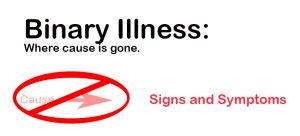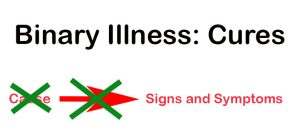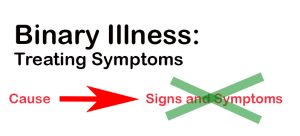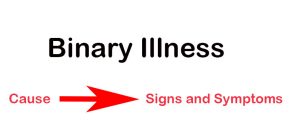This post was written very early in my studies of cure. To see a more comprehensive and up to date study of cure, go here: A Theory of Cure.
Modern medicine is mystified by cures. There is no useful medical nor scientific definition of cure or cured. Medical texts avoid the word cure, preferring ‘treatments’. Treatments don’t promise, don’t need to cure. Many current medical dictionaries simply do not contain the word cure – unbelievable, but true. What are cues? How do cures work? What is the science behind cures?
It’s not difficult to understand cures, when we make an effort. To understand cures, we need to simplify. First, we need to simplify illness. Only an illness can be cured.
Disease
Medicine diagnoses and treats diseases. The concept of disease is extremely complicated, ranging from a simple injury like a bruise or cut – to the complexities of a stage 4 cancer, and everything in-between. This complexity makes general study of ‘cure’ very challenging. First we need to simplify, so we can study simple diseases – understand simple cures. Then we can use what we learn, to develop complexity, building on those simple concepts.
Before we begin, we need to address an important question. What about ‘diseases’ that cannot be cured?
“Lord, grant me the strength to accept the things I cannot change, the courage to change the things I can, and the wisdom to know the difference.” — Reinhold Niebuhr
Disability
If it can’t be cured, it is not an illness. I might be described as a disability, a deficit, a handicap, or even a natural feature, but not an illness. We need wisdom to separate disability from illness. Illness can be cured. A disability might be a disease, it might be treatable, but it cannot be cured. On the other hand, it is important to believe that we can cure any medical condition. Belief is the first step. Faith does not make cures happen, but it makes them possible.
The word disability has considerable stigma. This is unfortunate. There is no gentle way to describe a disability, a handicap, or a deficiency. A disability, like a missing arm or leg is not a disease to be ‘cured’. We can sometimes cure, a disability, with surgery and healing. It might make sense to call cleft-lip an illness – that can be cured with surgery and healing. Perhaps, someday, we will learn to regrow missing fingers, then arms and organs – to convert those disabilities to a illnesses, which can be cured. The line between disease and disability is sometimes flexible.
Illness
An illness is what the patient has – a disease is what the doctor diagnoses. This is a standard medical quote, useful and true. The illness comes first. An illness must exist before it can be diagnosed – even if the patient is unaware. Illness might exist for a long time before it is diagnosed, sometimes, it cannot be diagnosed.
Every illness is an individual case. Only an individual case can be cured. Every illness has the potential to be cured, by definition. We can only cure specific, individual cases of a disease – an illness, what the patient has.
A disease is a general concept, describing a class of illnesses, used by doctors to plan a general treatment for an illness. A disease cannot be ‘cured’. Only an illness can be cured.
What is the simplest illness? The simplest illness has a single cause: a binary illness. A binary illness is the junction of a single cause and a set of consequences. Even the simplest illness can have many consequences.
It is possible, of course, to be exposed to many potential cause of illness, without becoming ill. It is also possible to have many signs and symptoms of a specific illness, without suffering that illness. An binary illness exists when a cause and a set of symptoms are linked.
Chains of Cause
When we look closely at cause, even the cause of a simple illness, we can always find a chain of causes. When we identify a cause of an illness, we can always ask “what is the cause of the cause“? When we find the cause of the cause, we can ask again “what is the cause of the cause of the cause“. Sometimes, we might first identify a middle-cause – and later find the cause that results from that middle-cause. Every illness has a ‘chain’ of causes. A binary illness has a single chain of causes.
Is the Cause Present and Active?
Sometimes the cause is present. The common cold is an illness with a cause that is present and active. A broken arm is a common illness where the cause is gone. These two types of cause require different types of cures.
 When the cause is gone – the cure is healing.
When the cause is gone – the cure is healing.
Healing is present before, during and after every illness. Healing cures are seldom perfect, often leaving damage that cannot be healed, cannot be cured. A broken arm can be healed, but the cure is seldom perfect. Healing is a cure.
Even when the cause is gone, it is important to identify the cause, to analyze chains of causes – to prevent future illnesses. Prevention is also a cure. It can cure illnesses before they occur.
When the cause is present, the cure is to address the cause, or the link between the cause and the signs and symptoms.
 There are two types of cures for a binary illness when the cause is present.
There are two types of cures for a binary illness when the cause is present.
First, a binary illness has a chain of causes. Successfully breaking the chain will cure the illness.
There is second path to cure – improving the health of the patient. When we improve the health of the patient it sometimes breaks the link between cause and the signs and symptoms, and thus cures the illness.
A bacterial infection is a binary illness that might be cured by addressing the cause – using an antibiotic that kills the infecting bacteria.
Many illnesses, like scurvy, obesity, and even starvation are cured by improving the health of the patient. When the health of the patient is improved – the illness fades and is cured. Healing takes time, and is seldom perfect, but the causal cure is complete. We might view these illnesses as caused by ‘not doing something‘. Starvation is caused by not consuming sufficient food. Scurvy is caused by not consuming a diet with sufficient Vitamin C. And obesity? We can view it as caused by not exercising sufficient constraint. Foods and nutrients don’t cause illness – the unhealthy use, or non-use, of foods can lead to an illness.
The illness is cured by health, by raising healthiness such that it breaks the link between the cause and the symptoms.
There are no ‘substances’, no medicines, that can cure. Even an antibiotic does not cure by itself, it must be prescribed, and taken as prescribed. If it is not taken, or not taken as subscribed, it cannot cure.
Cure Symptoms?
 It is not possible to cure the symptoms of an illness. Many medical treatments attempt to address an illness by treating symptoms. This is a valuable technique to provide relief for the patient – and it sometimes allows the body time to heal and cure the illness. However, addressing symptoms, without paying attention to cause, can often facilitate a simple illness’s growth making it chronic.
It is not possible to cure the symptoms of an illness. Many medical treatments attempt to address an illness by treating symptoms. This is a valuable technique to provide relief for the patient – and it sometimes allows the body time to heal and cure the illness. However, addressing symptoms, without paying attention to cause, can often facilitate a simple illness’s growth making it chronic.
Cures Improve Healthiness
The best cures are actions that improve the healthiness of the patient. A patient with scurvy might be treated with tablets of Vitamin C. These improve the patient’s symptoms, and appear to address the cause. However, they make the patient dependent on the medicine, and do not address the fundamental issue, the diet of the patient. Changing the diet of the patient is the best cure.
Treating an infection with an antibiotic does little to improve the health of the patient, and sometimes actually damages the healthy bacteria in the patient’s body. It is a technique used on the assumption that curing the illness is more critical than improving the health of the patient.
Side Effects and Iatrogenic Effects
It seems every medicine has a long list of side effects, and the longer you take the medicine, the mores severe the side effects. Does every cure have side effects? Actually, no. Some cures, like antibiotics, have negative side effects – because they work by killing bacteria and can kill healthy bacteria as well.
Cures that work by raising healthiness don’t have side effects, they have health effects. If you have scurvy, or obesity, and you health your diet – you might feel strange effects, but these are the health effects of the cure.
Why do most medicines have side effects? Because most medicines make no attempt to cure. Most medicines treat symptoms. The cause is not addressed – not even identified. When we address symptoms – the cause keeps pushing the patient – and new symptoms appear. Side effects are often proof that the medicine cannot cure.
A fundamental principle of medicine is to avoid action. Wait and see. Why? Iatrogenic effects are negative effects caused by medicines, or by medical actions. There is always danger when using a medicine, or a medical treatment – especially a medical treatment that cannot cure. Only doctors are allowed to diagnose, treat, and recommend treatments, because treatments can be dangerous.
The best way to avoid side effects and iatrogenic effects is to treat illness with healthiness. Most illnesses are not critical. Most illnesses can be prevented, treated and cured effectively with healthiness. Instead of ‘wait and see’, we should act to improve health.
Healthiness often Cures
The common cold is incurable, in current medical theory. But the common cold is cured easily by health. People who are healthier cure their colds faster, and get fewer colds as well. People who are less healthy get more colds, and they last longer. Health is the best treatment, health is the best cure – in non-critical situations. There are many illnesses that can only be healthed – and few that can be cured by medicines, because medicines – conventional or alternative, seldom address cause.
Summary:
There are three kinds of cures:
– healing
– address the cause
– prevention, prevent the cause
Treating symptoms does not cure.
Every illness can be cured. Every illness has the potential to be cured. When we give up, we are declaring the presence of a disability, not an illness.
Every active illness has an active cause, and can be cured by addressing the cause. Treating symptoms does not address the cause, and cannot cure.
Illnesses with Multiple Causes
What about illnesses with multiple causes, how can they be cured? You might find the answer using the concepts in this post. Or you can check the next post – which will answer that question.
to your health, tracy



